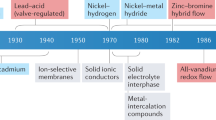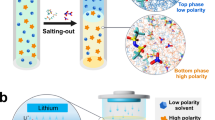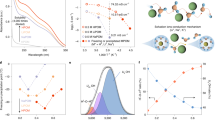Abstract
Aqueous K-ion batteries (AKIBs) are promising candidates for grid-scale energy storage due to their inherent safety and low cost. However, full AKIBs have not yet been reported due to the limited availability of suitable electrodes and electrolytes. Here we propose an AKIB system consisting of an Fe-substituted Mn-rich Prussian blue KxFeyMn1 − y[Fe(CN)6]w·zH2O cathode, an organic 3,4,9,10-perylenetetracarboxylic diimide anode and a 22 M KCF3SO3 water-in-salt electrolyte. The cathode achieves 70% capacity retention at 100 C and a lifespan of over 10,000 cycles due to the mitigation of phase transitions by Fe substitution. Meanwhile, the electrolyte can help decrease the dissolution of both electrodes owing to the lack of free water. The AKIB exhibits a high energy density of 80 Wh kg−1 and can operate well at rates of 0.1–20 C and over a wide temperature range (−20 to 60 °C). We believe that our demonstration could pave the way for practical applications of AKIBs for grid-scale energy storage.
This is a preview of subscription content, access via your institution
Access options
Access Nature and 54 other Nature Portfolio journals
Get Nature+, our best-value online-access subscription
$29.99 / 30 days
cancel any time
Subscribe to this journal
Receive 12 digital issues and online access to articles
$119.00 per year
only $9.92 per issue
Buy this article
- Purchase on Springer Link
- Instant access to full article PDF
Prices may be subject to local taxes which are calculated during checkout







Similar content being viewed by others
Data availability
The data that support the plots within this paper and other findings of this study are available from the corresponding author on reasonable request.
References
Yang, Z. et al. Electrochemical energy storage for green grid. Chem. Rev. 111, 3577–3613 (2011).
Dunn, B., Kamath, H. & Tarascon, J.-M. Electrical energy storage for the grid: a battery of choices. Science 334, 928–935 (2011).
Kim, H. et al. Aqueous rechargeable Li and Na ion batteries. Chem. Rev. 114, 11788–11827 (2014).
Eftekhari, A., Jian, Z. & Ji, X. Potassium secondary batteries. ACS Appl. Mater. Interfaces 9, 4404–4419 (2017).
Kim, H. et al. Recent progress and perspective in electrode materials for K-ion batteries. Adv. Energy Mater. 8, 1702384 (2018).
Kubota, K., Dahbi, M., Hosaka, T., Kumakura, S. & Komaba, S. Towards K-ion and Na-ion batteries as “beyond Li-ion”. Chem. Rec. 18, 459–479 (2018).
Qian, J. et al. Prussian blue cathode materials for sodium-ion batteries and other ion batteries. Adv. Energy Mater. 8, 1702619 (2018).
Wessells, C. D., Peddada, S. V., Huggins, R. A. & Cui, Y. Nickel hexacyanoferrate nanoparticle electrodes for aqueous sodium and potassium ion batteries. Nano Lett. 11, 5421–5425 (2011).
Wessells, C. D., Huggins, R. A. & Cui, Y. Copper hexacyanoferrate battery electrodes with long cycle life and high power. Nat. Commun. 2, 550 (2011).
Su, D., McDonagh, A., Qiao, S. Z. & Wang, G. High-capacity aqueous potassium-ion batteries for large-scale energy storage. Adv. Mater. 29, 1604007 (2017).
Suo, L. et al. “Water-in-salt” electrolyte enables high-voltage aqueous lithium-ion chemistries. Science 350, 938–943 (2015).
Leonard, D. P., Wei, Z., Chen, G., Du, F. & Ji, X. Water-in-salt electrolyte for potassium-ion batteries. ACS Energy Lett. 3, 373–374 (2018).
Liu, Y., Wei, G., Ma, M. & Qiao, Y. Role of acid in tailoring prussian blue as cathode for high-performance sodium-ion battery. Chem 23, 15991–15996 (2017).
Wu, X. et al. Diffusion-free Grotthuss topochemistry for high-rate and long-life proton batteries. Nat. Energy 4, 123–130 (2019).
Ren, W., Chen, X. & Zhao, C. Ultrafast aqueous potassium-ion batteries cathode for stable intermittent grid-scale energy storage. Adv. Energy Mater. 8, 1801413 (2018).
Nakamoto, K., Sakamoto, R., Ito, M., Kitajou, A. & Okada, S. Effect of concentrated electrolyte on aqueous sodium-ion battery with sodium manganese hexacyanoferrate cathode. Electrochemistry 85, 179–185 (2017).
Wu, X. et al. Vacancy-free prussian blue nanocrystals with high capacity and superior cyclability for aqueous sodium-ion batteries. ChemNanoMat 1, 188–193 (2015).
Wu, X. Y. et al. Energetic aqueous rechargeable sodium-ion battery based on Na2CuFe(CN)6-NaTi2(PO4)3 intercalation chemistry. ChemSusChem 7, 407–411 (2014).
Wu, X., Cao, Y., Ai, X., Qian, J. & Yang, H. A low-cost and environmentally benign aqueous rechargeable sodium-ion battery based on NaTi2(PO4)3–Na2NiFe(CN)6 intercalation chemistry. Electrochem. Commun. 31, 145–148 (2013).
Wu, X. Y. et al. Low-defect Prussian blue nanocubes as high capacity and long life cathodes for aqueous Na-ion batteries. Nano Energy 13, 117–123 (2015).
Bie, X., Kubota, K., Hosaka, T., Chihara, K. & Komaba, S. A novel K-ion battery: hexacyanoferrate(II)/graphite cell. J. Mater. Chem. A 5, 4325–4330 (2017).
Xue, L. et al. Low-cost high-energy potassium cathode. J. Am. Chem. Soc. 139, 2164–2167 (2017).
Moritomo, Y., Urase, S. & Shibata, T. Enhanced battery performance in manganese hexacyanoferrate by partial substitution. Electrochim. Acta 210, 963–969 (2016).
Wu, X. et al. Rocking-chair ammonium-ion battery: a highly reversible aqueous energy storage system. Angew. Chem. Int. Ed. 56, 13026–13030 (2017).
Yamada, Y. et al. Hydrate-melt electrolytes for high-energy-density aqueous batteries. Nat. Energy 1, 16129 (2016).
Lukatskaya, M. R. et al. Concentrated mixed cation acetate “water-in-salt” solutions as green and low-cost high voltage electrolytes for aqueous batteries. Energy Environ. Sci. 11, 2876–2883 (2018).
Suo, L. et al. Advanced high-voltage aqueous lithium-ion battery enabled by “water-in-bisalt” electrolyte. Angew. Chem. Int. Ed. 55, 7136–7141 (2016).
Nakamoto, K., . & Sakamoto, R. & Sawada, Y. & Ito, M. & Okada, S. Over 2 V aqueous sodium-ion battery with prussian blue-type electrodes. Small Methods 3, 1800220 (2019).
Suo, L. et al. “Water-in-salt” electrolyte makes aqueous sodium-ion battery safe, green, and long-lasting. Adv. Energy Mater. 7, 1701189 (2017).
Gao, H. & Goodenough, J. B. An aqueous symmetric sodium-ion battery with NASICON-structured Na3MnTi(PO4)3. Angew. Chem. Int. Ed. 55, 12768–12772 (2016).
Hou, Z., Li, X., Liang, J., Zhu, Y. & Qian, Y. An aqueous rechargeable sodium ion battery based on a NaMnO2–NaTi2(PO4)3 hybrid system for stationary energy storage. J. Mater. Chem. A 3, 1400–1404 (2015).
Fernández-Ropero, A. J., Saurel, D., Acebedo, B., Rojo, T. & Casas-Cabanas, M. Electrochemical characterization of NaFePO4 as positive electrode in aqueous sodium-ion batteries. J. Power Sources 291, 40–45 (2015).
Pasta, M. et al. Full open-framework batteries for stationary energy storage. Nat. Commun. 5, 3007 (2014).
Kumar, D., Rajouria, S. K., Kuhar, S. B. & Kanchan, D. K. Progress and prospects of sodium-sulfur batteries: a review. Solid State Ion. 312, 8–16 (2017).
Hesse, H., Schimpe, M., Kucevic, D. & Jossen, A. Lithium-ion battery storage for the grid—a review of stationary battery storage system design tailored for applications in modern power grids. Energies 10, 2107 (2017).
Opiyo, N. Energy storage systems for PV-based communal grids. J. Energy Storage 7, 1–12 (2016).
Hueso, K. B., Armand, M. & Rojo, T. High temperature sodium batteries: status, challenges and future trends. Energy Environ. Sci. 6, 734 (2013).
Díaz-González, F., Sumper, A., Gomis-Bellmunt, O. & Villafáfila-Robles, R. A review of energy storage technologies for wind power applications. Renew. Sustain. Energy Rev. 16, 2154–2171 (2012).
Soloveichik, G. L. Battery technologies for large-scale stationary energy storage. Annu. Rev. Chem. Biomol. Eng. 2, 503–527 (2011).
Fetcenko, M. A. et al. Recent advances in NiMH battery technology. J. Power Sources 165, 544–551 (2007).
Yabuuchi, N., Kubota, K., Dahbi, M. & Komaba, S. Research development on sodium-ion batteries. Chem. Rev. 114, 11636–11682 (2014).
Pan, H. L., Hu, Y. S. & Chen, L. Q. Room-temperature stationary sodium-ion batteries for large-scale electric energy storage. Energy Environ. Sci. 6, 2338–2360 (2013).
Liang, Y. et al. Universal quinone electrodes for long cycle life aqueous rechargeable batteries. Nat. Mater. 16, 841–848 (2017).
Lee, M. et al. High-performance sodium–organic battery by realizing four-sodium storage in disodium rhodizonate. Nat. Energy 2, 861–868 (2017).
Ravel, B. & Newville, M. ATHENA, ARTEMIS, HEPHAESTUS: data analysis for X-ray absorption spectroscopy using IFEFFIT. J. Synchrotron Radiat. 12, 537–541 (2005).
Kresse, G. & Furthmuller, J. Efficient iterative schemes for ab initio total-energy calculations using a plane-wave basis set. Phys. Rev. B 54, 11169–11186 (1996).
Perdew, J. P., Burke, K. & Ernzerhof, M. Generalized gradient approximation made simple. Phys. Rev. Lett. 77, 3865–3868 (1996).
Anisimov, V. I., Zaanen, J. & Andersen, O. K. Band theory and Mott insulators—Hubbard U instead of Stoner I. Phys. Rev. B 44, 943–954 (1991).
Xiao, P., Song, J., Wang, L., Goodenough, J. B. & Henkelman, G. Theoretical study of the structural evolution of a Na2FeMn(CN)6 cathode upon Na intercalation. Chem. Mater. 27, 3763–3768 (2015).
Acknowledgements
This work was supported by the National Natural Science Foundation of China (51725206 and 51421002), the National Key Technologies R&D Programme of China (2016YFB0901500), and the Strategic Priority Research Programme of the Chinese Academy of Sciences (XDA21070500), the Strategic Priority Research Programme of the Chinese Academy of Sciences (XDA21070500) and the Beijing Municipal Science and Technology Commission (Z181100004718008).
Author information
Authors and Affiliations
Contributions
Y.-S.H. and Y.L. designed this work; L.J. synthesized the cathodes and carried out the electrochemical experiments and first-principles calculations; C.Z. performed the structural refinement, L.L. carried out the Raman test, J. Zhang and X.Y. performed the hXAS test; Q.Z. performed the transmission electron microscopy test, X.S. and J. Zhao performed the inductively coupled plasma test. L.J., Y.L. and Y.-S.H. wrote the paper; all of the authors participated in analysis of the experimental data and discussions of the results as well as preparing the paper.
Corresponding authors
Ethics declarations
Competing interests
The authors declare no competing interests.
Additional information
Publisher’s note: Springer Nature remains neutral with regard to jurisdictional claims in published maps and institutional affiliations.
Supplementary information
Supplementary Information
Supplementary Figs. 1–14, Supplementary Note 1, Supplementary Tables 1–9 and supplementary references
Rights and permissions
About this article
Cite this article
Jiang, L., Lu, Y., Zhao, C. et al. Building aqueous K-ion batteries for energy storage. Nat Energy 4, 495–503 (2019). https://doi.org/10.1038/s41560-019-0388-0
Received:
Accepted:
Published:
Issue Date:
DOI: https://doi.org/10.1038/s41560-019-0388-0
This article is cited by
-
Alkaline-based aqueous sodium-ion batteries for large-scale energy storage
Nature Communications (2024)
-
A Molecular-Sieving Interphase Towards Low-Concentrated Aqueous Sodium-Ion Batteries
Nano-Micro Letters (2024)
-
Design strategies for rechargeable aqueous metal-ion batteries
Science China Chemistry (2024)
-
Practical assessment of the energy density of potassium-ion batteries
Science China Chemistry (2024)
-
Mn-based cathode materials for rechargeable batteries
Science China Chemistry (2024)



